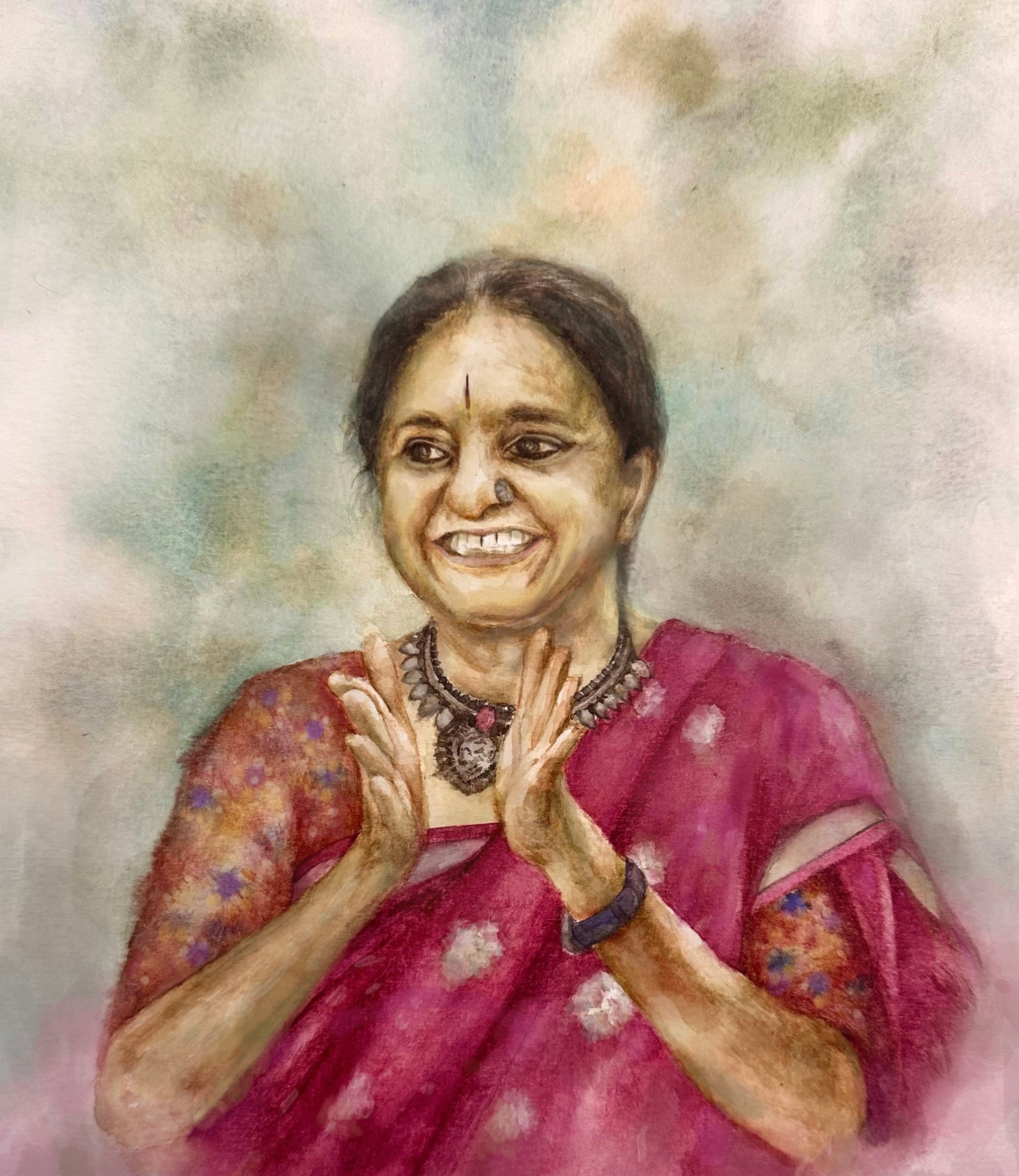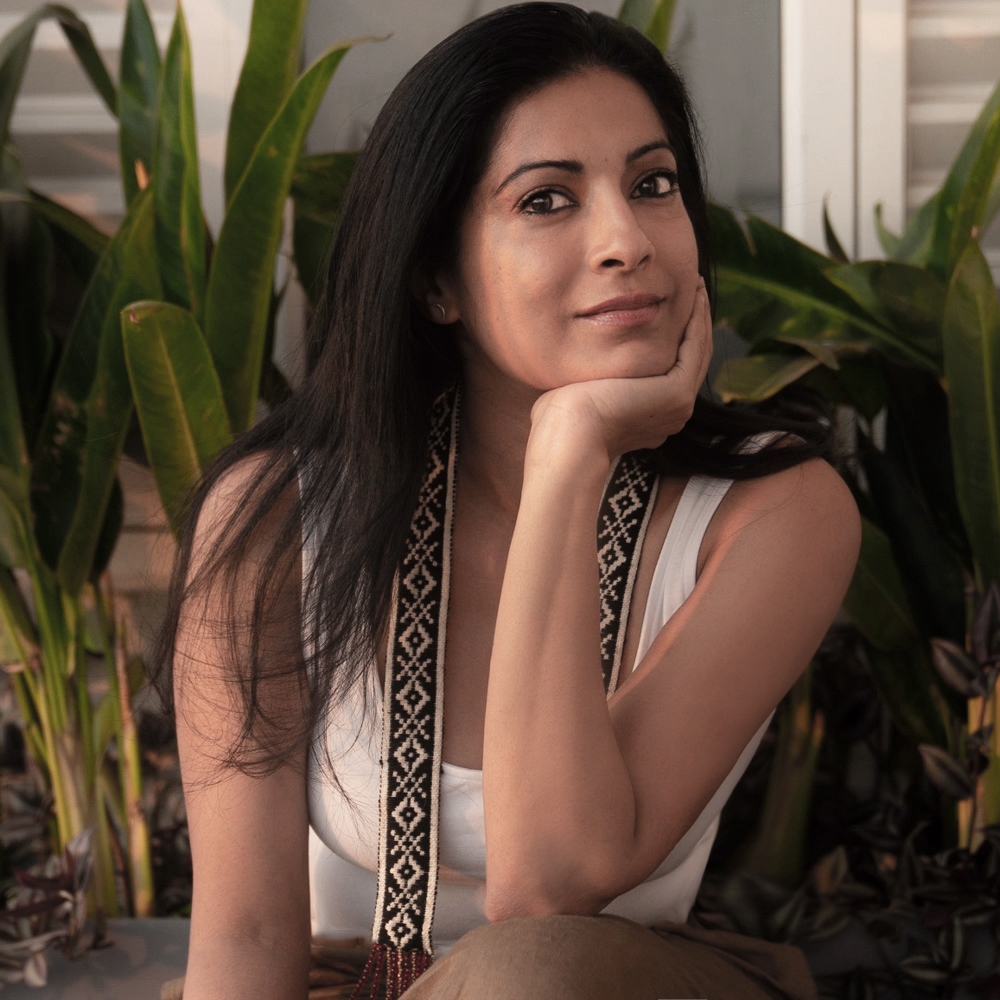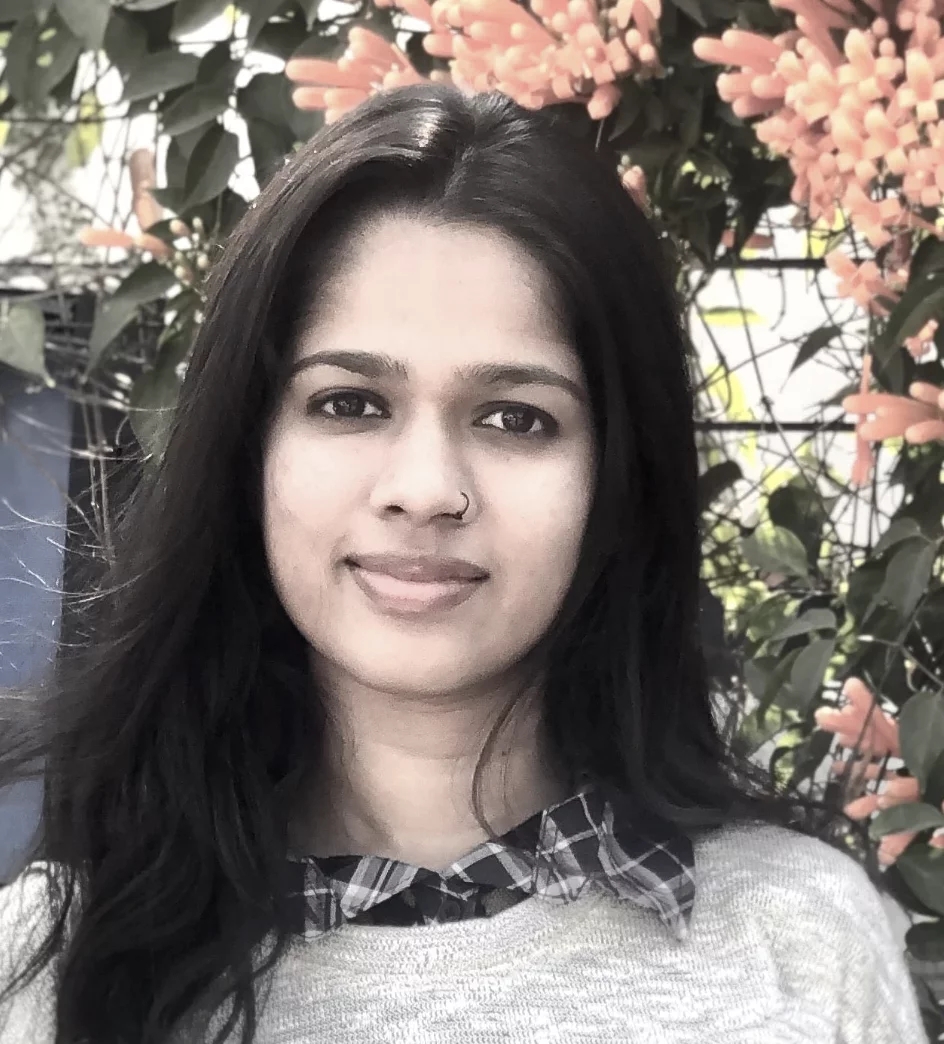WORDS BYRamya Reddy
ILLUSTRATIONS BYRupali Goel
Stories often arrive before their tellers.
They come as a family’s sayings, the bustle of a kitchen, a glance across a room.This conversation is with Geeta Ramanujam, who has spent a lifetime inviting people into that first space where listening becomes understanding.
Geeta founded Kathalaya in Bangalore, a storytelling academy that trains teachers, parents and professionals, and carries stories into classrooms, neighbourhoods and boardrooms with presence rather than spectacle. Kathalaya, as both place and practice, is a circle that invites each teller to find an instrument that is truly theirs, and to listen first. The focus here, too, is listening—the craft that reads a room, the discipline that turns sound into meaning, the universality that lets a story cross age and language. With Geeta, we linger among Tamil proverbs learned at home and English words offered by a father who loved language; follow how attention ripens a tale, how silence works as grammar, how a single image moves a crowd.
If storytelling is what you see, listening is the work beneath it, quiet and deep, and it is the heart of this conversation.

Ramya Reddy: Geeta, can you tell me how the earliest seed of storytelling took root in your early life?
Geeta Ramanujam: The seed was there within; I’d even say it’s a little genetic. We’re all storytellers; some get the chance to express it, some don’t. In the telling, ordinary talk becomes story. Even as a child, people would stop and listen to me. I became the family entertainer because I was good at emoting.
My parents were great storytellers. My mother taught me Tamil through proverbs—half I didn’t understand then, but it’s a beautiful way to learn by listening. She was strict and could hold a crowd; that made listening a discipline. My father gave me English, he used beautiful words and patiently explained meanings. Language came to me through them, and they mostly spoke in stories. That’s the foundation.
Ramya: What made your mother so passionate about storytelling?
Geeta: From my maternal line, my great-grandmother was an excellent storyteller who conveyed everything through proverbs. My grandmother inherited this gift; she loved to learn and even returned to school after becoming a grandmother so she could read the English newspaper. She would narrate the news as stories, often beginning with, “Do you know why Jackie married Onassis?” This way, the day’s events transformed into engaging narratives.
However, there was another side to our home, which I refer to as “mind weather.” My mother exhibited two contrasting sides. Listening to both aspects of her taught me discernment—what to embrace and what to ignore, what to express and what to keep silent about. I’m grateful for this childhood experience, as it helped me sense when her mood would shift.
Ramya: How old were you when you sensed this?
Geeta: Six or seven. I’d go out to play when she was in that mood. My father and I exchanged glances—we both knew. His first lesson to me was: “Don’t react. Watch the situation and respond within yourself. The minute you react, it triggers something.”
Ramya: You've often mentioned that storytelling starts with listening. How has listening shaped who you are?
Geeta: With my mother, “Listen” meant listen. Because she spoke in proverbs, you had to catch every word. She was short-tempered, so you had to be sharp. We grew up in Bombay in a big joint family; she packed dabbas for everyone. I helped grind the chutney every morning to the exact consistency she wanted. She gave instructions and ended with a proverb. I’d want to ask its meaning, but mornings were hectic. I’d come home in the evening when she was in a good mood and ask, “What did you mean?” Then she’d tell the whole story. That rhythm—hear, wait, return— taught me patience in listening. My father, in a gentler key, made listening joyful: he’d use a new English word and explain it unhurriedly.
Ramya: And the stories themselves? You grew up with proverbs and epics. Do you remember a small story that turned something in you?
Geeta: Many were spiritual—about gods and saints, and side-tales about impermanence and not grieving. One that stayed: Narada asked Narayana for a word that would help people. “Say my name,” said Narayana. Narada came to earth, saw a dying worm, said “Narayana,” and the worm died. He said it to a frog; the frog died. To a cow; the cow died. He thought, “I’m saying it wrong,” and resolved to keep silent. On his way back, a king begged him to bless his daughter. Narada said, “Narayana.” Nothing dramatic happened; the bride smiled: “Do you recognise me? I was the worm, then the frog, then the cow. Each time your word carried me forward. Today I have a human birth because of you.” The lesson: everything has a purpose; not every ending is loss.
Ramya: When did storytelling become your path rather than just a love?
Geeta: I didn’t plan it. I accepted life as it came. I married in my second year, and later another door opened. I became a teacher. In class, I used stories. Then I was placed in a school library, so I studied Library and Information Science. Since children weren’t reading, I would tell them just enough about a book to pique their curiosity. They would then rush for that very book. I thought, “I’ve found a solution,” but I still didn’t think, “I’m a storyteller.”
In 1996, someone requested a week-long storytelling workshop—a very unusual request at the time. I planned five days on epics and legends, and our school gardener helped bring them to life by making simple props and backdrops and arranging the space. It was a great success. A small newspaper piece followed. Someone travelling through Bangalore invited me to train their teachers. Everything happened overnight. My daughter later asked, “How did you devise your three-day course?” I hadn’t written anything down; it just came. Only after the first few batches did I give written notes. Today I’ve finished 179 batches. Oral transmission sits easily in me.
Ramya: In the communities I work with, knowledge is kept alive in spoken traditions rather than on the page. When I began working with the communities for my book, I learnt to keep the camera aside so I could meet elders without a lens between us. I didn’t name it then, but that choice became a practice of listening. You often say storytelling begins with listening—beyond hearing. In practical terms, what does that look like? You’ve spoken of “reflective and contemplative listening” – how does that anchor your work at a time when we seem to be losing the habit of truly listening?
Geeta: There are different layers to listening. People often talk about “reflective listening,” which involves thinking about a story after it has ended. I would like to introduce the concept of “contemplative listening”: this means looking inward while the story unfolds around you. When I am honest with myself, the story becomes clearer to others. They aren’t just hearing it; they’re also visualizing what I’m experiencing.
Recently, I shared "The Blossom Tree" with a small audience of children and elders. No props or theatrical elements—just my voice. No one in the audience moved for over an hour. I realized that while the audience remained the same, I had changed. The more I engage in stillness, prayer, and simple attention, the clearer my storytelling. If you remain open, messages can arrive unexpectedly. Listening also means noticing these signals and allowing them to guide you forward.
Ramya: You also speak about being porous to signals.
Geeta: Yes. If you’re open, messages arrive. Someone read an e-story of mine at a club for autistic children and wrote to thank me. I wondered whether to write a book; Penguin called in that same window. And years earlier, after my father passed away in 1995, a man came to the library and asked, “Do you know what death is?” He spoke for three days, left me a hundred pages to reflect on, and said, “Don’t get in touch again. Your life will change; you will travel and become a light to many.” I didn’t believe him. Two months later came that first city workshop; then another. I like to think I’m living a strand of my father’s unfinished desire. Perhaps that too is listening—carrying forward what those we love set in motion.
Ramya: We are drowning in noise, don't you think? If an adult wanted to find a way back to deep listening, where should they begin?
Geeta: With subtraction. List what distracts you: devices, habits, the compulsion to keep up. Ask: if I step away, what truly happens? Much of the anxiety is borrowed. Change your environment when you can. A walk by a lake or a day in the hills can make a difference; where you are matters. The mind tends to relax and rearrange itself in peaceful surroundings. Instead of rushing to label it as "meditation," observe. Notice a man reading a newspaper with his leg resting against a wall, while another reads the headlines over his shoulder. Pay attention to how birds stay away when the air isn't right, or how a sapling leans slightly, as if recalling a past wind. The more you observe, the more the world responds to you. Attention enhances your storytelling.
Ramya: In various settings—schools, festivals, corporate rooms—do people listen differently? What opens them up, and what shuts them down?
Geeta: A story told from the heart resonates in every space. When we say, “The mountain felt sad,” both a child and a CEO can understand that feeling. It’s not just information that connects with people; it’s recognition. Metaphor engages the listener within the story. Facts alone are flat; it is emotions that provide depth.
People tend to close off when the storytelling attempts to control the room—whether by seeking approval, trying to outshout restlessness, or using language as a barrier. If I focus on distractions (“that person isn’t listening”), the story loses its impact. The audience reflects my inner state. When I am grounded, they are more present.
There is also the human impulse to consider. For instance, when I speak about Steve Jobs, I begin with the Japanese potter he visited—an old man devoted to clay for years. It moved Jobs. He asked, “How can I have what he has? How do I contain myself and let go of expectations like this man?” That reflection is more compelling than recounting how he founded Apple. It’s the shared human connection that truly resonates.

Ramya: Your point about the human impulse—the Jobs-and-the-potter image—reminds me of a line often attributed to a Native American proverb: “Tell me a fact and I’ll learn. Tell me a truth and I’ll believe. But tell me a story, and it will live in my heart forever.” You also spoke about sacred silence. I think of listening as beyond the ears; it happens in the spaces between sounds. How do you think about silence when you’re telling a story? Is there room for silences?
Geeta: Silence is the grammar—commas and full stops. Without them, the sentence doesn’t breathe, and neither does a story. People don’t really “listen” to words; they visualize pictures. My work is to give them time to see.
Geeta: Silence is the grammar—commas and full stops. Without them, the sentence doesn’t breathe, and neither does a story. People don’t really “listen” to words; they visualize pictures. My work is to give them time to see.
“The orange scratch in the sky thins; cloud edges drift; a wash of pink gives way to blue.” If I hurry, they miss the sky—and the one bird crossing it. If I pause too long, I break the spell. The craft is in letting the image settle and then carrying it forward. You don’t stop the story from being silent; you bring the silence into the movement of the story.
Ramya: You’ve trained hundreds of tellers. How do you handle comparison and confidence?
Geeta: Don’t try to do it “like her” or “like him”. Find your instrument. Some paint a story and narrate with brush and breath. Introverts bloom with puppets. Musicians let the raga carry the tale. I give room for different forms and styles. On presentation day, they bring new stories.
Language is not a barrier. You can express yourself in whatever language you think in, whether it’s Tamil, Marathi, Gujarati, Japanese, or even Armenian and Yiddish. Someone can always summarize. The essence of a story is conveyed when the storyteller is authentic. I used to worry about getting credit for my work. However, someone once mentioned to me, "There’s a storyteller named Geeta Ramanujam who tells this beautifully," without realizing that’s me! Now, I no longer have those concerns. If Kathalaya has contributed to creating a movement, nurturing storytellers, and reviving this art form, I am truly grateful. The art itself is greater than any one individual.
Ramya: What can storytelling offer us now to restore trust, sustain attention, and widen our capacity for care?
Geeta: Listening to a story brings you back to your inner self. It opens the heart and allows your soul to connect. Even when you're busy, taking a moment to sit and listen can lead to a sense of relaxation and peace. During those few minutes, you reconnect with yourself and the deeper source within you, which often feels distant in today’s world. This source represents peace, calmness, joy (ānanda), and love that reside in each person.
Ramya: How do stories themselves change when they pass from teller to teller, culture to culture? Is there a difference between telling a story and then carrying it forward?
Geeta: Even for the teller who created a story, it evolves over time. Like bards and ballads—like old wine: the more you experience it, the more beautiful. People who listen often want to tell the same story. They do, but audiences say, “We came to hear it from the horse’s mouth.” It can never be the same because your inner life has to enter the telling. The story is there, but the rendering matters.
Ramya: Two key ideas stand out to me: the importance of listening—in its various forms—and what you mentioned about allowing things to flow naturally. When we impose constraints on ourselves with "musts"—like "I must write this in English" or "I must record this"—we limit our creativity. By removing those constraints, everything changes.
Geeta: I’ve taught many university open courses. Recently, a university requested my materials; a young coordinator rejected them because they didn’t fit a three-semester template and then dismissed them as “only good for a one- or two-day workshop.” It made me ask: how are we judging learning—by clocks and boxes, or by freedom and creativity? I left it at, “It’s okay, maybe it’s not meant for this semester.” But I will not give up my creativity because of that. Unfortunately, many people want rubrics that are presented in bullet points. If I say the ego is simply the ninth letter of the alphabet—“I”—how much importance do we give to that one little stroke and dot!
Ramya: That brings us to the end of my questions. It’s been one hour—I don’t know how it flew. Is there anything you'd like to add as a message to budding storytellers or everyone at large?
Geeta: The most important thing right now is to cope with the world we live in while also monitoring your own well-being. Just like a train needs two parallel rails to stay on track, avoid mixing your personal life with your professional life; otherwise, the train may derail. We often blend our personal and professional lives every day. Instead, consider them as two parallel tracks of a single journey. As you advance your career, also invest in your inner life: practice listening to yourself, take time for self-reflection, and make space for personal growth. Nurture both aspects. Listen to your own stories.
Ramya: Beautiful. I’m not going to add anything to that. Thank you so much, Geeta.
Geeta: Thank you, Ramya.

